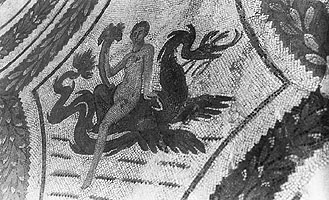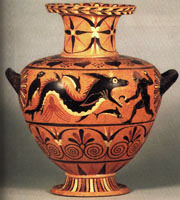
 Sea monster, familiar of sea deities - notably Poseidon and Thetis (one of her mutations in the fight with Peleus) - but also becoming a popular decorative motif. It is a creature set by Poseidon to devour Hesione and Andromeda, but killed by Herakles and Perseus respectively. In early art it resembles a lion-fish (a shark?) but from the 5th century has a pointed muzzle (like a crocodile) with long ears, gills and a long fishy body, sometimes with lion forelegs but usually flippers. In late art it is used to signify Jonah's whale.
Sea monster, familiar of sea deities - notably Poseidon and Thetis (one of her mutations in the fight with Peleus) - but also becoming a popular decorative motif. It is a creature set by Poseidon to devour Hesione and Andromeda, but killed by Herakles and Perseus respectively. In early art it resembles a lion-fish (a shark?) but from the 5th century has a pointed muzzle (like a crocodile) with long ears, gills and a long fishy body, sometimes with lion forelegs but usually flippers. In late art it is used to signify Jonah's whale.
Above left: Mosaic.Tunis. Musée National du Bardo A 1. © Musée National du Bardo
Above right: Detail from Caeretan black-figure clay vase from Stavros S. Niarchos collection. John Boardman, Classical Art Pl. VII 71. Photo. S.Hertig; Zurich University Collection. © Zurich University Collection.